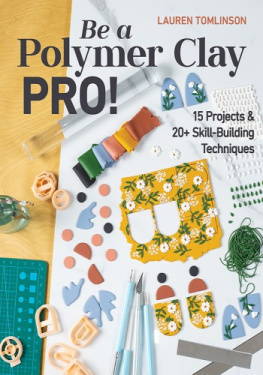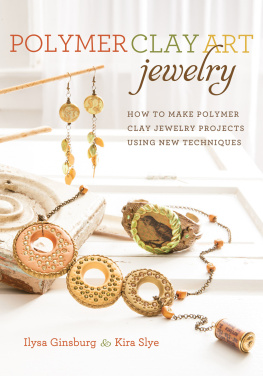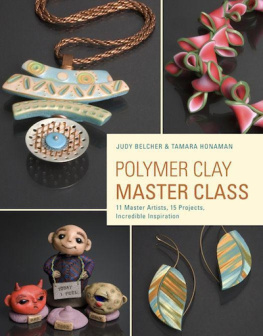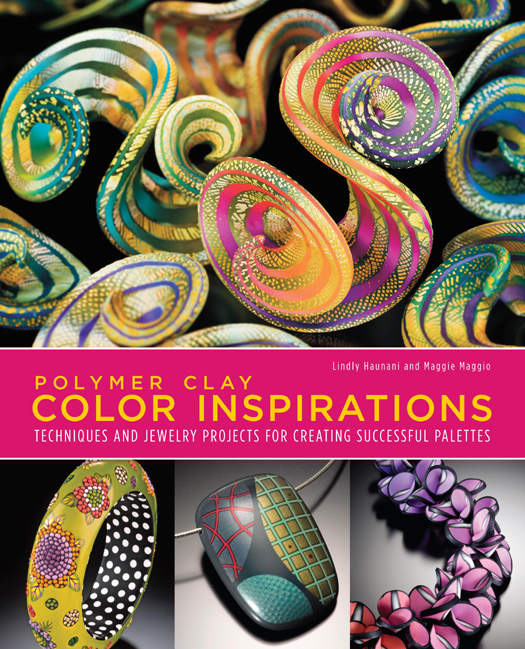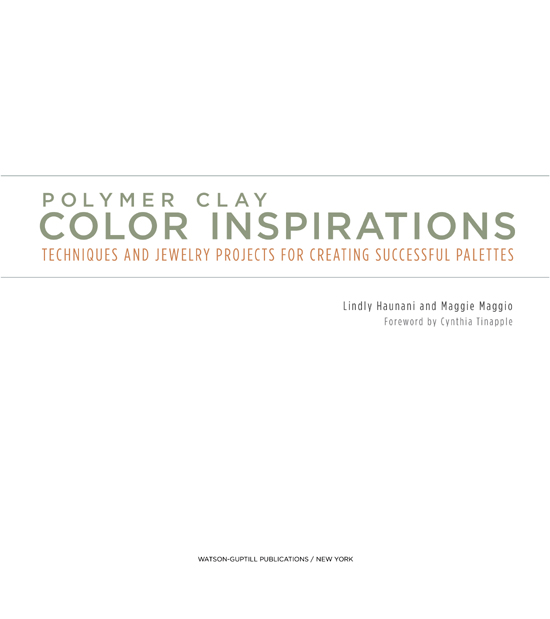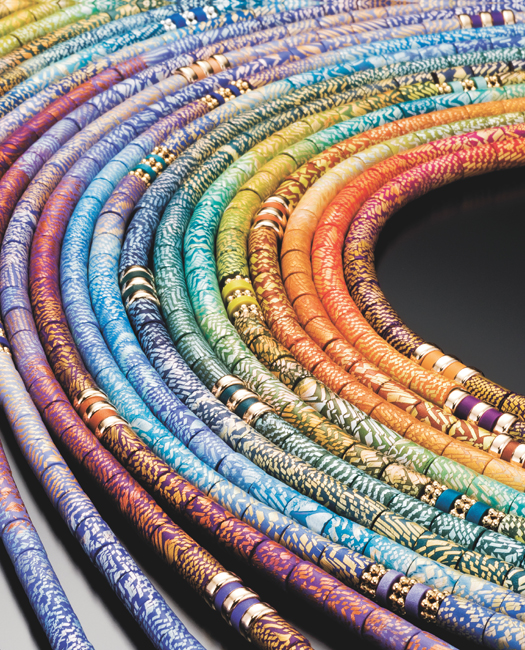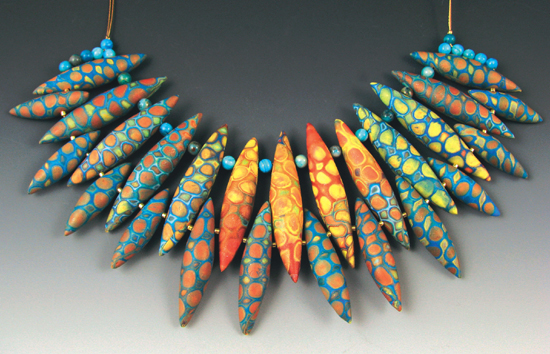Editorial Director: Victoria Craven
Executive Editor: Joy Aquilino
Editor: Patricia Fogarty
Art Director: Jess Morphew
Designer: DelicARTessen Design
Production Director: Alyn Evans
First published in 2009 by Watson-Guptill Publications, an imprint of the Crown Publishing Group, a division of Random House, Inc., New York
www.crownpublishing.com
www.watsonguptill.com
Copyright 2009 by Lindly Haunani and Maggie Maggio
Library of Congress Control Number:2009920543
Trade paperback ISBN: 978-0-8230-1501-6
eBook ISBN: 978-0-307-96564-6
All rights reserved.
Unless otherwise specified, photographs are by Doug Barber.
Cover design by Dominika Dmytrowski; cover artists/photographers (top, then bottom left to right): Elise Winters/Hap Sakwa, Deb DeWolff/Larry Sanders, Dan Cormier/Robert Diamante, Lindly Haunani/Hap Sakwa
v3.1
ACKNOWLEDGMENTS
We are both deeply grateful to be part of a community of polymer clay artists who continue to explore, innovate, and generously share their discoveries. Over the years our workshop students have taught us an enormous amount. A special group of artists, The Color ExplorersDayle Doroshow, Jan Frame, Judy Kuskin, Hollie Mion, Carol Simmons, and Cynthia Tinappleprovided the ongoing encouragement we needed to write this book. Homage must be paid to our dear friend Judith Skinner, who invented the Skinner blend, which is integral to many of the techniques presented in this book. Two artists no longer working in polymer clay also deserve our special thanks for sharing their insights: Laura Liska and Pier Voulkos.
Thanks are also in order to three of the polymer clay manufacturersEberhard Faber, Polyform Products, and Van Akenwho generously donated the clay that was used for the exercises, projects, and charts included in this book.
We deeply appreciate the patient support and technical assistance we have received from Chuck Maggio, Annie Maggio, Monica Maggio, David Vanover, our project editor Patricia Fogarty, and our editor Joy Aquilino.
CONTENTS
CHAPTER ONE:
Polymer Clay Color Basics: A Primer
CHAPTER TWO:
Understanding the Three Properties of Color
CHAPTER THREE:
Finding Your Inspirational Colors
CHAPTER FOUR:
Choosing Your Colors for a Project Palette
CHAPTER FIVE:
Mixing Colors That Flow
CHAPTER SIX:
Orchestrating Color Combinations
CHAPTER SEVEN:
Playing Games with Color
CHAPTER EIGHT:
Exploring Color Composition: Placement and Proportion
CHAPTER NINE:
Exploring Pattern and Texture in Your Colors
CHAPTER TEN:
Putting It All Together
FOREWORD
You may think youll never get color the way Lindly and Maggie do, but dont let the weight and complexity of this book fool you. If you read a bit, play with some color exercises, and push through your resistance to color theory, your work and your understanding will take a giant leap forward.
As in all disciplines, it takes just one glimmer of recognition for learning to begin. Whether your approach to color is visceral or cerebral, through your head or your hands, youll benefit immensely by following along as Lindly and Maggie share the secrets theyve learned from their years of research.
In the 1990s, I edited their early articles for the National Polymer Clay Guild newsletter. Scrutinizing their grammar forced me to read and reread the articles, and I began to understand color. For years after that, I arranged to sit near Lindly and Maggie at conferences and classes because I knew that at some point, the oracle would speak. As I muddled and fussed with a design, over my shoulder Id hear a calm voice say, Add blue, or You have only middle values. A light and a dark will help. My goal has been to internalize that oracle.
Every day I browse through hundreds of designs and sculptures on the Web, as I hunt for good polymer clay art examples for my blog PolymerClayDaily.com, which is frequented by artists around the globe. What Ive found is that excellent color can rescue a mediocre design. And color thats off the mark or muddied can ruin the finest concept. Your palette becomes your signature.
That signature is very personal. Its tied to culture and geography and weather. It shifts with latitude, with attitude, and with age. Learning about color means learning about yourself.
Read through the concepts in this book. Some exercises will seem elementary. Do them anyway. Some wont make sense to you. Trust them and experiment a little. I guarantee that if you persist, youll hear the oracle.
Cynthia Tinapple
JUDY DUNN . Shibori Collar. 28 inches long. Polymer clay, blue-dyed lace agate beads, rhodium-plated seed beads, nylon-coated bead cord, and sterling silver friction clasp.
The pattern on the surface of these beads reminds me of the patterns found in shiborisubtle variations in color, lines and borders that feather. The beads combine in a variety of ways, creating a flow of dashes, lines, rays, sometimes static and sometimes kinetic.
Photo by Judy Dunn
PREFACE: WHO WE ARE AND HOW WE WORK
We have found color to be the most challenging and directly expressive way of imparting voice and message to our work. While we share the same ultimate goal when working with colorto create successful color combinationsthere are differences in our approaches.
Maggie is fascinated with the analysis of color systems that have appeared throughout history. Her library contains hundreds of books about color. She is always asking why? and conducting color experiments to find the answers. She considers polymer clay the best medium for exploring the various systems strengths and shortfalls while attempting to simplify a very complex subject. This is evidenced in her unique base-mixing system for making color-mixing scales using polymer clay.
Lindly is inspired by the visceral and emotive potentials of working with color. Her approach to color is informed by her lifelong passion for cooking. She prefers to rely on her experience and intuitionas in a bit of this, a bit of that, taste, then adjust. When designing a color scheme, she is often inspired by the different interlocking colors of food as they appear in a recipe, season, or cuisine.
There are times when we miss the mark. When a color choice turns out to be too strident or passive when combined with other colors, we need to make adjustments in our mixes, try new colors or adjust the proportions. How we arrive at our solutions is as different as our unique personalities and our personal color preferences. For both of us, the underlying concepts are the samecombine knowledge with instinct, take time to gain perspective while looking closely, and be prepared to make adjustments.
Learn to trust your instincts, while relying on swatches.
Through your life experiences you have learned a lot about your color preferences and have compared colors while making choices many times. Shopping for clothes is a great example. Suppose you want to buy a red sweater to match a pair of pants in your wardrobe. You could conduct an analysis of the color of the pants and make a list of possible red color matches. In a more likely scenario, you take the pants to the store and hold them next to the red sweaters and decide which one looks right. In the same way, when you are working on a polymer clay project, having a number of swatch variations available will allow you to make more instinctual color choices.


